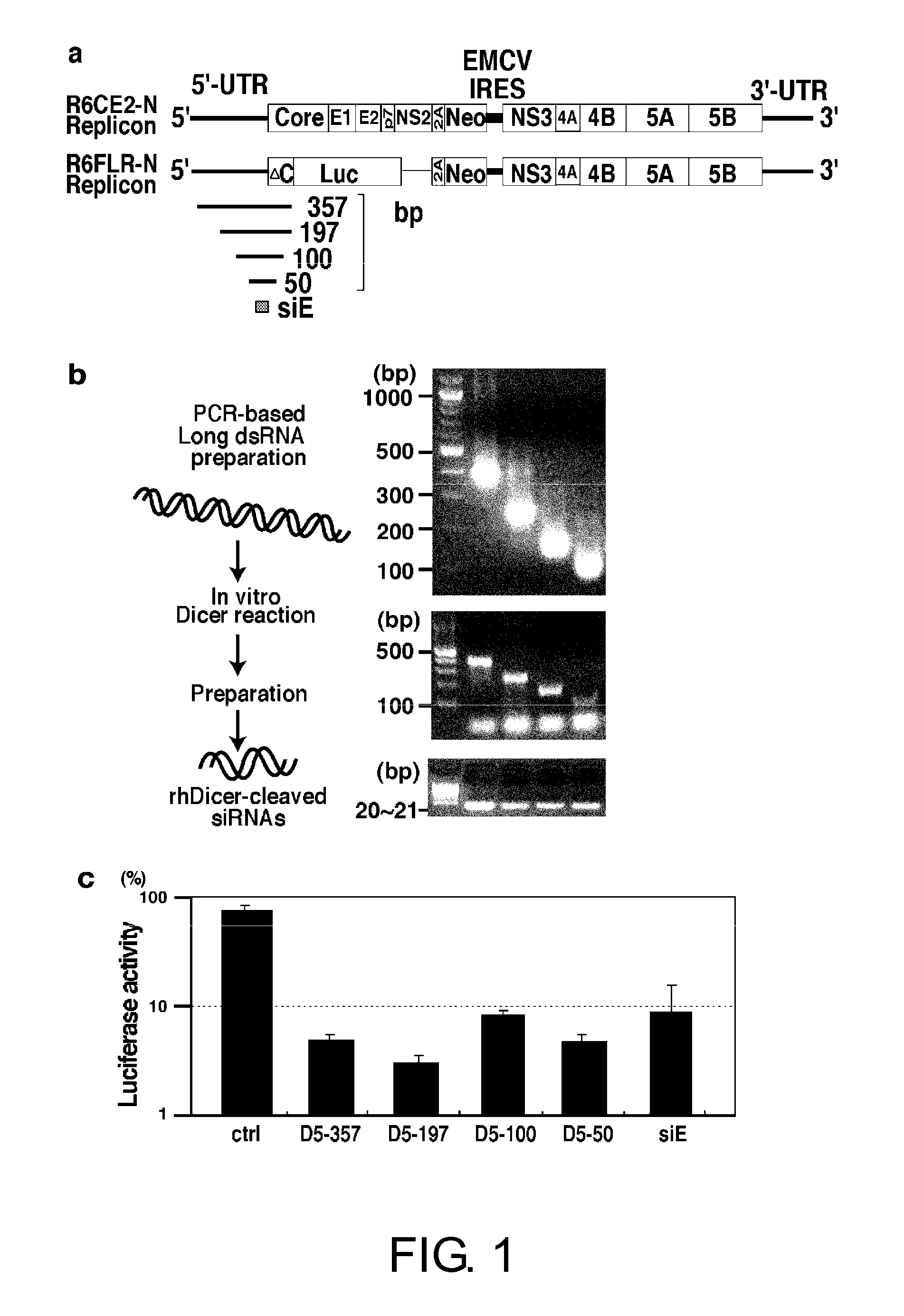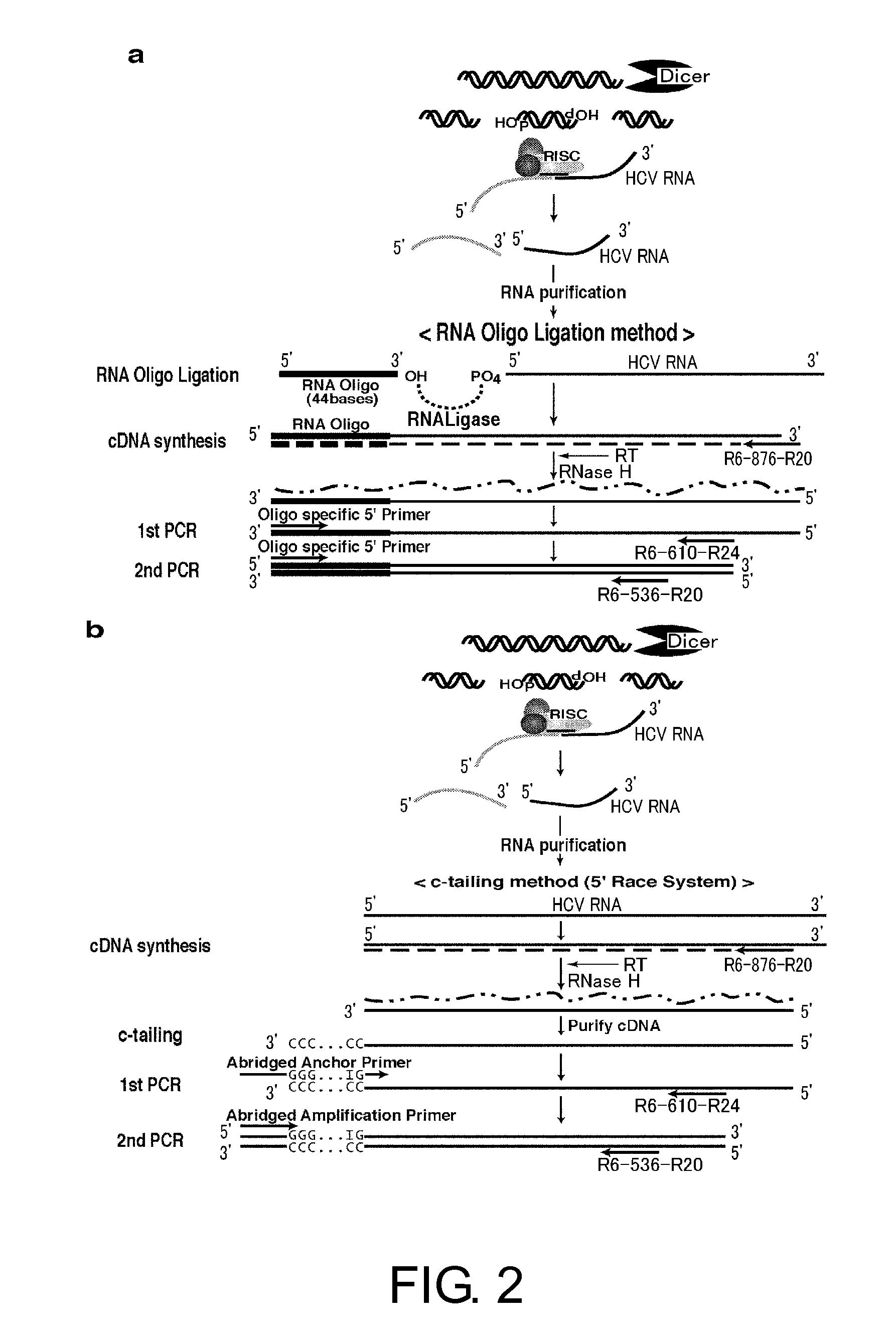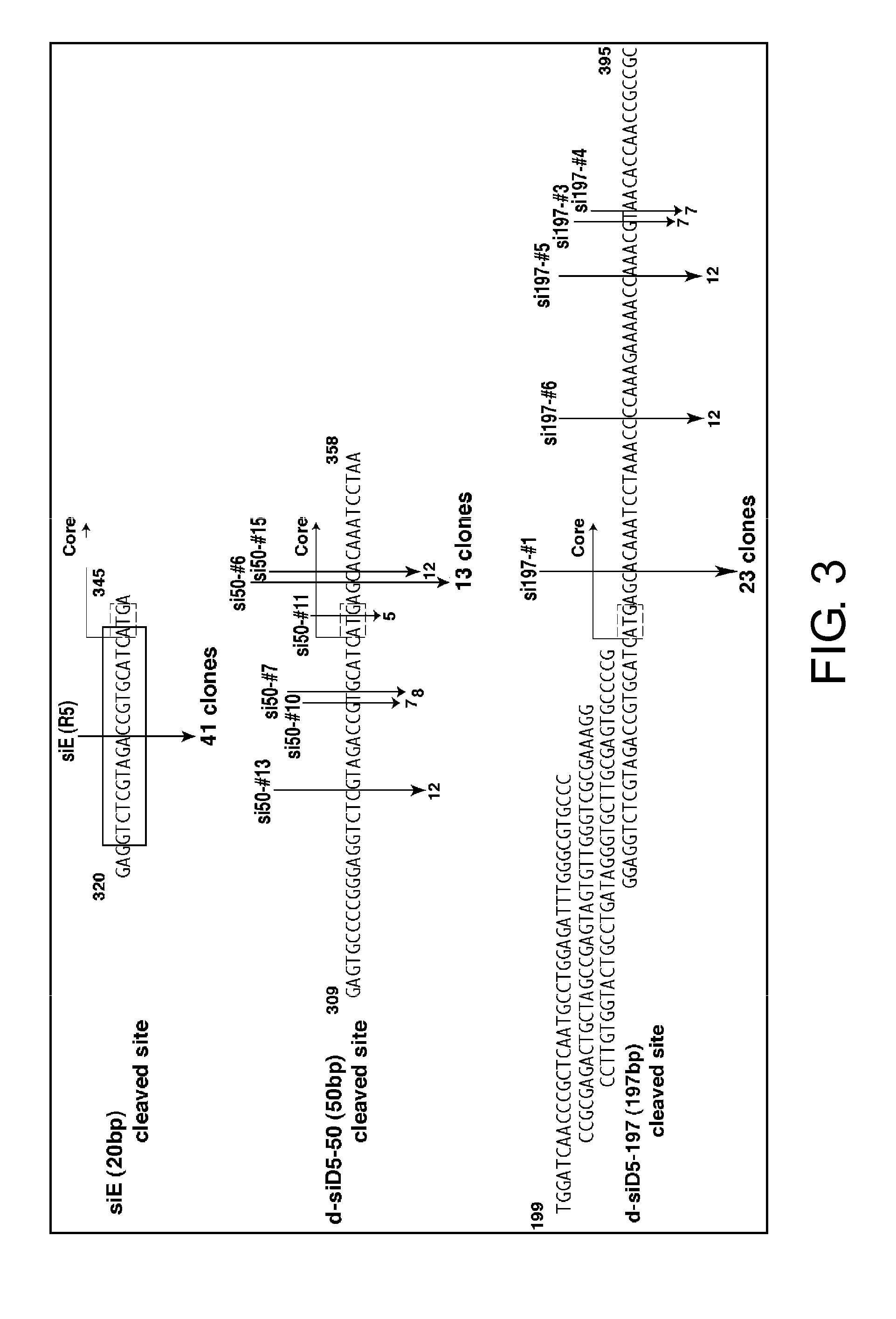Oligoribonucleotide or Peptide Nucleic Acid Capable of Inhibiting Activity of Hepatitis C Virus
a technology of hepatitis c virus and oligonucleotide, which is applied in the field of oligonucleotides or peptide nucleic acids, can solve the problems of high drug price, frequent induction of adverse effects, and 30% efficacy rate, and achieve the effect of inhibiting the activity of hepatitis, effective rnai activity, and inhibiting the ability to replicate virally
- Summary
- Abstract
- Description
- Claims
- Application Information
AI Technical Summary
Benefits of technology
Problems solved by technology
Method used
Image
Examples
example 1
Analysis of Sites Cleaved by Diced siRNAs in HCV Replicon RNAs
[0078]Transfection of Diced siRNAs
[0079]On the day before the start of the experiment, div. bla n3 cells carrying an HCV replicon were plated in 6-well plates (BECTON DICKINSON, cat. #353046) at 250,000 cells / 2 ml / well using DMEM+GlutaMAX-I (Invitrogen, cat. #10569-044) supplemented with 5% inactivated FCS (Invitrogen, cat. #26140-079).
[0080]On the first day of the experiment, div. bla n3 cells were transfected with a diced siRNA (D5-50 or D5-197) (FIG. 3) at a final concentration of 30 nM using the Lipofectamine 2000 Reagent (Invitrogen, cat. #11668-019). This method (according to the product manual) is described below.
[0081]The diced siRNA for transfection was diluted to 300 nM with OPTI-MEM I (Invitrogen, cat. #22600-050) containing 0.23% NaHCO3. Meanwhile, Lipofectamine 2000 was diluted to 3% with 0.23% NaHCO3 / OPTI-MEM I, and this was gently mixed and allowed to stand at room temperature for five minutes. An equal vol...
example 2
Assessment of Designed siRNAs for the Replication Inhibitory Activity on HCV Replicons
[0115]
[0116]Each siRNA sample was diluted to 0.108 μM with opti-MEM containing 0.23% NaHCO3, and then further diluted to prepare a three-fold dilution series of ten stages. Each sample of the dilution series was added at 10 μl / well in triplicates to a Multiplate 96FII (white) for cell culture (Sumitomo Bakelite Co., cat. #MS-8096W) for luciferase assay and a 96-well plate (BD, cat.#353072) for cytotoxicity assay. The Lipofectamine RNAiMAX Reagent (Invitrogen, cat.#13778-150) was diluted to 1% with OPTI-MEM I containing 0.23% NaHCO3, and added at 10 μl / well to the wells of the 96-well plates into which the siRNAs were aliquoted. This was mixed thoroughly, and incubated at room temperature for 20 minutes to prepare siRNA / Lipofectamine complexes. Lipofectamine RNAiMAX alone was added to control wells. In this Example, HCV replicon cells containing the luciferase gene are R6FLR41-14 cells, FLR3-1 cells...
example 3
Assessment of si50 and si197 for the Inhibitory Activity on HCV Protein Synthesis by Western Blotting
[0122]
[0123]Each siRNA sample was diluted to 18 nM with opti-MEM containing 0.23% NaHCO3, and this was added to 6-well plates at 500 μl / well. 2.5 μl of Lipofectamine RNAiMAX was added to the siRNAs aliquoted in each well of the 6-well plates. This was mixed thoroughly, and incubated at room temperature for 20 minutes. After counting the number of R6 FLR41-14 cells, they were suspended in DMEM+GlutaMax-I containing 10% inactivated FCS, and plated in 6-well plates at 155,000 cells / 2.5 ml / well (the final siRNA concentration was 3 nM). The cells were incubated at 37° C. under 5% CO2. After 72 hours, the culture medium was discarded, and the cells were washed once with PBS(−). Then, PBS(−) was removed by aspiration, and the samples were prepared from the 6-well plates using 60 μl of RIPA (1% SDS, 0.5% Nonidet P-40 (nacalai tesque, cat. #23640-94), 150 mM NaCl, 10 mM Tris-HCl (pH 7.5), 1× ...
PUM
| Property | Measurement | Unit |
|---|---|---|
| Fraction | aaaaa | aaaaa |
| Fraction | aaaaa | aaaaa |
| Frequency | aaaaa | aaaaa |
Abstract
Description
Claims
Application Information
 Login to View More
Login to View More - R&D
- Intellectual Property
- Life Sciences
- Materials
- Tech Scout
- Unparalleled Data Quality
- Higher Quality Content
- 60% Fewer Hallucinations
Browse by: Latest US Patents, China's latest patents, Technical Efficacy Thesaurus, Application Domain, Technology Topic, Popular Technical Reports.
© 2025 PatSnap. All rights reserved.Legal|Privacy policy|Modern Slavery Act Transparency Statement|Sitemap|About US| Contact US: help@patsnap.com



